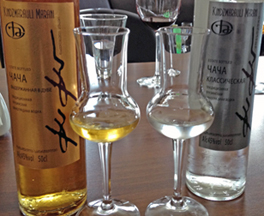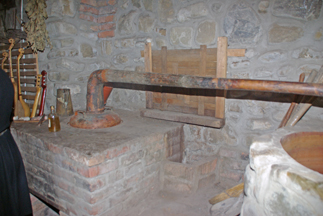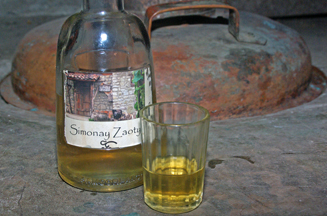
Chacha
by
Terry Sullivan
 We first traveled to the country Georgia during the grape harvest of 2013. It did not take long to realize that the people in this country, south of the Greater Caucasus Mountains, liked their wine and a distilled alcohol spirit called Chacha. Chacha is a Georgian word for pomace. It is the skins, seeds and stems left over after pressing the grapes or wine. Many people in the country make their own wine, especially in the countryside. A large percentage of those also have stills and distill the pomace. The resulting spirit offers floral notes and dried fruits. Chacha has a long aftertaste of dried fruits.
We first traveled to the country Georgia during the grape harvest of 2013. It did not take long to realize that the people in this country, south of the Greater Caucasus Mountains, liked their wine and a distilled alcohol spirit called Chacha. Chacha is a Georgian word for pomace. It is the skins, seeds and stems left over after pressing the grapes or wine. Many people in the country make their own wine, especially in the countryside. A large percentage of those also have stills and distill the pomace. The resulting spirit offers floral notes and dried fruits. Chacha has a long aftertaste of dried fruits.
Commercial wineries also distill the pomace and make Chacha. We saw simple still operations as well as those with large gleaming, brass stills. The leftover pomace is usually quite soaked with wine. This is placed in the pot and heated. The resulting vapor cools and a crystal clear liquid runs out. Some of the commercial wineries will age the Chacha in oak barrels for months to years resulting in the gold colored spirit.
 One of the larger distillery buildings was at the Kindzmarauli Marani, a winery in Kvareli, Kakheti, Georgia. Gleaming brass and stainless still columns and pots distill wine and pomace to make Chacha. Each year Kindzmarauli Marani produces 200,000 bottles of Chacha. Kindzmarauli Marani produces two Chachas. One was clear, a blend of Saperavi grape pomace and white grapes. The Chacha had notes of dried fruit and alcohol. The second Chacha was a dark yellow. It was aged in an oak barrel for one year. The result was a Chacha with notes of alcohol, dried fruit and caramel.
One of the larger distillery buildings was at the Kindzmarauli Marani, a winery in Kvareli, Kakheti, Georgia. Gleaming brass and stainless still columns and pots distill wine and pomace to make Chacha. Each year Kindzmarauli Marani produces 200,000 bottles of Chacha. Kindzmarauli Marani produces two Chachas. One was clear, a blend of Saperavi grape pomace and white grapes. The Chacha had notes of dried fruit and alcohol. The second Chacha was a dark yellow. It was aged in an oak barrel for one year. The result was a Chacha with notes of alcohol, dried fruit and caramel.
Some families have larger stills. At Simon Zaoty, in the Kakheti region, we saw one of the larger stills in a distillery building at the family home. Simon poured a shot of Chacha that spent a few months in oak prior to bottling. The Chacha was a dark yellow color. Alcohol and nectarines were apparent on the aroma and taste. There was some alcohol burn followed by a long aftertaste of yellow stone fruits.
 Storytelling
Storytelling
The Georgians are master storytellers. Of course a story centers around Chacha. God and the devil were having a discussion nearing an argument. God tired of the devil’s bantering, put his foot down. God decided that anyone who drinks one to three glasses of Chacha per day belongs to Him. Anyone who drinks more than three glasses of Chacha per day belongs to the devil. Now, when the Georgians learned of this rule, they were not happy. They conceived of a plan to fool the devil. They would drink the Chacha so fast, usually in one gulp, that the devil could not keep track of the number of glasses they would drink. We had the experience of drinking Chacha in one swallow. As a sign of friendship and good will, people will intertwine arms and swallow a shot of Chacha before the devil can count.
Proofing Down
As with many spirits, the distiller will proof down the final product. Most Chachas were in the 40% to 45% alcohol range (80 proof to 90 proof). Kindzmarauli distills to 68 percent alcohol and then adds water to bring it to 45 percent alcohol for the Chacha. However, we learned that not everyone likes those low alcohol spirits. At Zurab Topuridze Wine Cellar in Sakvavistkhe, Guria, Georgia, we tasted an intense Chacha. It was tasty with a high alcohol of over 60 percent (120 proof). According to Zurab’s cousins “drinking a 40 percent alcohol Chacha is a waste of time.”
It is difficult to find Chacha outside of the country Georgia. What makes Chacha unique, among other pomace brandies, is the varietal grapes used to make it. The Georgian native varieties Saperavi and Rkatsiteli are the most prolific black and white grapes in the country, and they are often used in making Chacha.


Family distillery at Simon Zaoty in Kakheti region of Georgia
Article written October 2016
